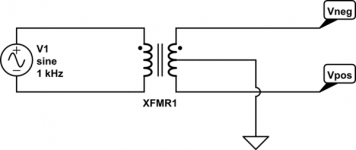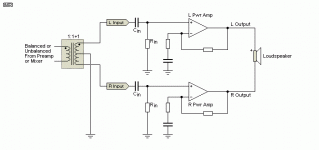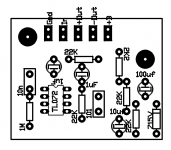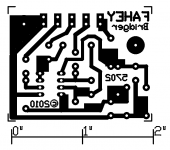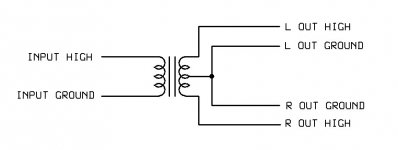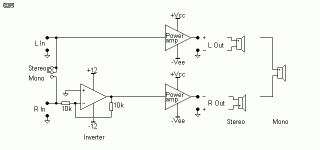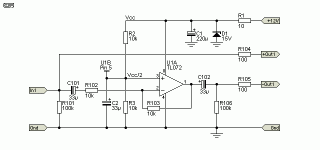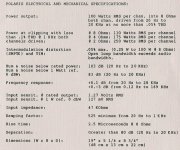I am trying to bridge two amplifiers. Neither have a bridging switch. I was told that my amps can in fact be bridged but would need to reverse polarity on one input on each amp. I have searched the internet for countless hours and have not found a single device that will do this. I guess they do not exist. I have two Sumo Polaris amps that I want to bridge. How do I invert the polarity? Can this even be done? Thank you.
More information on transformer bridging circuit here: Simplest Ever Bridging Adapter for Amplifiers
Attachments
I apologize but this is all over my head. I am just a guy who loves to listen to music. I am not a technician/electrical engineer. Therefore I need a consumer product that can solve this situation. I don't want to buy different amps at this time. Could this possibly be built into the amplifier already? Could I test this by connecting the two speaker wires to both positive terminals on the amp and connect the rca cables as usual? Would I damage anything by doing this? Thank you.
I HAVE designed and built a "Bridger", a small 2" by 1.5" PCB which gets a standard input and outputs 2 out of phase signals,exactly for that purpose.
Fed from anything above +15 (so you can use your current amp supply), uses a humble TL072 and a few resistors and capacitors, you can make your own PCB (I supply the artwork) or just use perfboard, problem is:WILL you build it?
You don´t e even need a case (the PCB can be mounted inside your current amp with a single screw) nor a power supply (just use available amp supply) but ... ummmm .... you will ned to build it ... this is DO IT YOURSELF Audio after all.
Total cost less than 10$ by the way.
Fed from anything above +15 (so you can use your current amp supply), uses a humble TL072 and a few resistors and capacitors, you can make your own PCB (I supply the artwork) or just use perfboard, problem is:WILL you build it?
You don´t e even need a case (the PCB can be mounted inside your current amp with a single screw) nor a power supply (just use available amp supply) but ... ummmm .... you will ned to build it ... this is DO IT YOURSELF Audio after all.
Total cost less than 10$ by the way.
Attachments
Last edited:
Altering the polarity or rather, inverting the phase of the input signal to one of the amplifiers, is safer than tinkering about inside an amplifier and risking the chance of then getting professional help, should things go wrong.......I need a consumer product that can solve this situation......Could this possibly be built into the amplifier already? Could I test this by connecting the two speaker wires to both positive terminals on the amp and connect the rca cables as usual? Would I damage anything by doing this? Thank you.
As you may think, that means you need an external device such as a preamp or separate box and power supply with the capability to invert one of its output signals. The option to invert inputs is, or at least was, possible in car audio but not in domestic audio systems, as far as I know, so you most likely will need to become a DIYer or enlist one's practical aid, if you want to add a bridging adaptor to your audio system.
There are kits of components as well as DIY project articles and PCBs to get you started but this will be DIY and the results will be according to your understanding of constructing electronic device, your tools and capabilities.
Try this article for starters: Bridging Adapter For Power Amps
Here's a retail PCB and parts level kit of a Silicon Chip magazine design that isn't from China Bridge Mode Adaptor for Stereo Amplifiers | Jaycar Electronics
Could this possibly be built into the amplifier already?
Polaris II and III are bridgeable according to the manual/spec sheets on this page.
Apparently, there is a mono/stereo switch inside these models.
I hope you can find an internal mono/stereo switch like Tim says.
If not, there is really nothing more simple than placing a bridging transformer in front of your stereo inputs. The attached diagram may make it clearer how to do so.
An example of what to buy is here: SOWTER TYPE 3575 TRANSFORMER
That one is rather expensive, but there may be cheaper alternatives out there.
If not, there is really nothing more simple than placing a bridging transformer in front of your stereo inputs. The attached diagram may make it clearer how to do so.
An example of what to buy is here: SOWTER TYPE 3575 TRANSFORMER
That one is rather expensive, but there may be cheaper alternatives out there.
Attachments
Last edited:
Tell us what the amps are please, that advice could be bogus, in which case you risk destroying something. And what is the load impedance? If the impedance of the load is too low bridging will just risk blowing up the amps or sending them into protection. An amp able to drive only down to 4 ohms cannot drive less than 8 ohms when bridged.I am trying to bridge two amplifiers. Neither have a bridging switch. I was told that my amps can in fact be bridged but would need to reverse polarity on one input on each amp.
They're not needed for prof. audio as most amps have invert switches and bridging switches come to that.I have searched the internet for countless hours and have not found a single device that will do this. I guess they do not exist. I have two Sumo Polaris amps that I want to bridge. How do I invert the polarity? Can this even be done? Thank you.
You might have identified a gap in the market...
True this is. When I was in the professional theatre business, there was often a request to transform outputs from home/amateur/low-grade equipment into professional balanced levels. Just to end in either upgrading mediocre commercial 'hifi' stuff to a serious level at high cost, or accept low level performance.You might have identified a gap in the market...
No 'translations' ('transcription-from-latin') found in the market. Different stages, different perspectives, different solutions.
A balanced bridged inverter does the job, single input, no adjustments, stable, perfect symmetry and wide band. So simple. No commercial enterprise existing.
So, You want a commercial device. Buy a small mixer and use the hot output for Left & the Cold output for Right, but make sure it's balanced, and not pseudo balanced ******** (Ring or middle XLR pin must output sound). A balanced pre-amp or an equalizer will also do it.
I am going to look into that Jaycar kit. But I don't know. It seems like something that I could end up messing up and damaging my amplifier. Probably best left to a professional. Thank you all for your suggestions.
You just need an inverting op-amp at unity gain and a few resistors. Connect this to one of the channels input. Of course You will also need a supply, perhaps You have 12V or 15V inside the amp ready for powering. Positive speaker terminal will be the other channel. A switch mounted on the outside lets You choose between normal & inverted input.
Take a look at mixer output schematics. Main (Hot) Op-amp Output connects directly to XLR pin 2, but the same signal connects to a second cascaded op-amp, gets inverted, and then connects to pin 3. You just need that second op-amp.
Take a look at mixer output schematics. Main (Hot) Op-amp Output connects directly to XLR pin 2, but the same signal connects to a second cascaded op-amp, gets inverted, and then connects to pin 3. You just need that second op-amp.
Tell us what the amps are please, that advice could be bogus, in which case you risk destroying something. And what is the load impedance? If the impedance of the load is too low bridging will just risk blowing up the amps or sending them into protection. An amp able to drive only down to 4 ohms cannot drive less than 8 ohms when bridged.
They're not needed for prof. audio as most amps have invert switches and bridging switches come to that.
You might have identified a gap in the market...
The both amps are Sumo Polaris. The input impedance is 47 KOhms. Is that too low? These amps will be driving Magnepan LRS speakers.
From the manual:
Attachments
Left field says...
When I was a kid learning electronics, I remember first trying to figure out what "reverse poultry" was. Fortunately, my electrical and English skills improved somewhat despite these early slips 🙂
When I was a kid learning electronics, I remember first trying to figure out what "reverse poultry" was. Fortunately, my electrical and English skills improved somewhat despite these early slips 🙂
- Home
- Amplifiers
- Solid State
- How to reverse polarity
